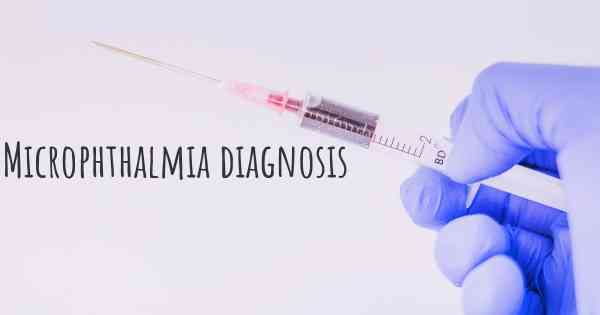How is Microphthalmia diagnosed?
See how Microphthalmia is diagnosed. Which specialists are essential to meet, what tests are needed and other useful information for the diagnosis of Microphthalmia

How is Microphthalmia diagnosed?
Microphthalmia is a rare eye condition characterized by abnormally small eyes. It can occur as an isolated condition or as part of a syndrome. Diagnosing microphthalmia involves a comprehensive evaluation by a healthcare professional, typically an ophthalmologist or a pediatrician specializing in eye disorders.
Medical History and Physical Examination
The diagnostic process usually begins with a detailed medical history review. The healthcare provider will inquire about the patient's symptoms, family history, and any other relevant information. This helps in understanding the context and potential causes of microphthalmia.
Following the medical history, a thorough physical examination is conducted. The healthcare provider will carefully examine the eyes, looking for signs of microphthalmia such as small eye size, abnormal eye shape, or other associated abnormalities. They may also assess visual acuity and perform additional tests to evaluate the overall eye health.
Imaging Studies
Imaging studies play a crucial role in diagnosing microphthalmia. They provide detailed visual information about the eye structures and aid in confirming the diagnosis. The most commonly used imaging techniques include:
- Ultrasound: This non-invasive imaging method uses sound waves to create images of the eye. It helps in assessing the size, shape, and internal structures of the eye, especially in infants and young children.
- Magnetic Resonance Imaging (MRI): MRI uses powerful magnets and radio waves to generate detailed images of the eye and surrounding structures. It provides a more comprehensive view and can help identify any associated brain abnormalities.
- Computed Tomography (CT) Scan: CT scans use X-rays to create cross-sectional images of the eye. They can provide detailed information about the eye's structure and help identify any bony abnormalities.
Genetic Testing
Since microphthalmia can be associated with genetic abnormalities, genetic testing may be recommended to identify any underlying genetic mutations or syndromes. This involves analyzing the patient's DNA to look for specific gene mutations or chromosomal abnormalities that may be responsible for microphthalmia.
Genetic testing can be performed through various methods, including:
- Chromosomal Microarray Analysis (CMA): CMA is a high-resolution genetic test that detects small deletions or duplications of genetic material. It can identify chromosomal abnormalities associated with microphthalmia.
- Gene Sequencing: This technique involves sequencing specific genes known to be associated with microphthalmia. It can help identify mutations within those genes.
- Whole Exome Sequencing (WES): WES is a comprehensive genetic test that analyzes the protein-coding regions of the entire genome. It can identify mutations in genes not typically associated with microphthalmia, potentially revealing novel genetic causes.
Additional Evaluations
In some cases, additional evaluations may be necessary to assess the impact of microphthalmia on other body systems or to identify associated abnormalities. These evaluations may include:
- Systemic Examination: A thorough examination of other body systems may be conducted to check for any associated abnormalities or syndromes.
- Electroretinography (ERG): ERG measures the electrical responses of the retina to light stimulation. It helps evaluate the function of the retina and can provide valuable information about the visual prognosis.
- Visual Field Testing: This test assesses the patient's peripheral vision and can help determine the extent of visual field loss, if present.
Conclusion
Diagnosing microphthalmia involves a combination of medical history review, physical examination, imaging studies, genetic testing, and additional evaluations. The process aims to identify the presence of microphthalmia, determine its severity, assess any associated abnormalities, and understand the underlying causes. Early diagnosis is crucial as it allows for appropriate management and intervention to optimize visual outcomes and address any associated health concerns.








